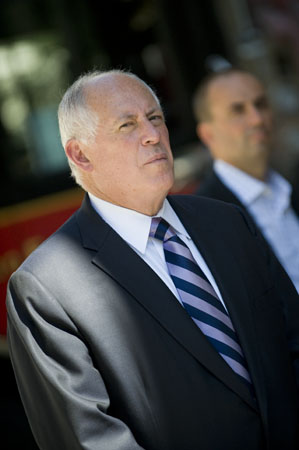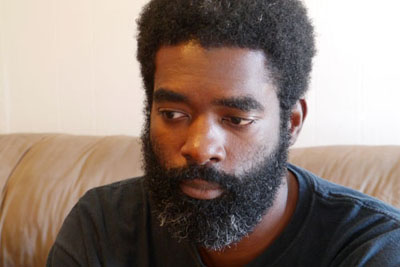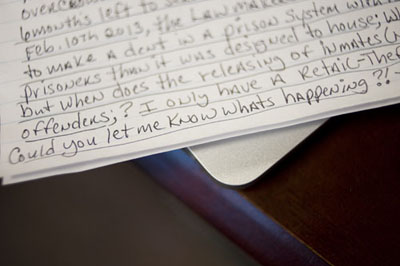Gov. Quinn keeps public in the dark on prison conditions
By Rob Wildeboer

Gov. Quinn keeps public in the dark on prison conditions
By Rob Wildeboer
Conditions are deteriorating and recently released inmates say it’s not just unpleasant punishment, it’s inhumane and abusive.
The crisis has been brewing for a long time, invisible behind cement walls and wire fences. Governor Pat Quinn seems determined to keep it from public view.
Over the last several months WBEZ has been requesting visits to two minimum security facilities to see what taxpayers are getting for the billion dollars they spend each year on prisons.
Gov. Quinn says no.
When Jerome Suggs was sentenced for driving on a revoked license he was sent to Vienna, a minimum security prison near the southernmost point in Illinois, about 350 miles from Chicago. Suggs was assigned to live on the third floor of a building but there was absolutely no view.
“When I moved up there there was boards up on the windows and I was just looking like, ‘Wow! What is this?” Suggs said. This was Building 19.
Suggs says there was not a single window letting in light and that he was put in a large room with several hundred other men. All of the men were crowded onto bunks with nothing to do. Suggs says toilets often broke and overflowed, resulting in a strong sewage smell.

When the weather turned hot the boards came off the windows but then bugs could easily get in through the broken windows. Suggs, who got out just last month, says the place was also overrun with cockroaches.
“Yes! On my bed! Oh yeah. Used to have to swat them off the bed,” he said.
“Okay, my name is Mayo and I was incarcerated for 29 and a half continuous years.” Mayo, who asked that we use just his first name, was convicted in the early ’80s for committing armed robbery. For the last three years of his sentence he was in Vienna and spent some of that time in the now notorious Building 19.
Mayo says, “I thought to myself this is supposed to be a minimum security institution, but this was more like a maximum security institution in that I couldn’t believe that they would actually expect people to live under those type of conditions. The place is infested with rats and the rats were so aggressive that we used to call them kangaroo rats ‘cause while I was there quite a few guys had rats actually jump up in bed with them.”
Mayo says living in a room with a hundred men, there was constant noise and chaos. And he says there was always tension.
Mayo says he knows prisoners aren’t supposed to be coddled but they’re not supposed to be abused either.
“Your punishment is the time you’re doing and you shouldn’t be subjected to further punishment by being mistreated while you’re there,” Mayo said.
Okay, one last, and disturbing, example of life in Building 19. It comes from attorney Alan Mills at the Uptown People’s Law Center in Chicago. Mills says a cockroach burrowed into the ear of an inmate while he slept and it had to be surgically removed.
“The wax in [the] ear is one of the things that roaches will eat,” Mills said. Mills has talked to inmates at Vienna but he hasn’t actually been allowed to see the conditions for himself.
John Maki has. “Building 19 was one of the most depressing things I’ve seen in my life,” Maki said. “I just thought this is a human tragedy on a lot of levels. Part of me thought what a terrible way to spend taxpayer dollars.”
Maki is executive director of the John Howard Association, a prison watchdog group.

After reading Maki’s report on Vienna last winter I submitted a request to the department of corrections to spend two days there and two days in another minimum security prison, Vandalia. The reports out of the two prisons raise serious questions. I figured people in Illinois who pay for these places should know firsthand what goes on, so they can be part of a smart public debate on what to do.
Governor Pat Quinn has refused WBEZ’s request.
Our initial efforts to get inside were denied with one-line emails. Spokeswoman Brooke Anderson eventually had one ten-minute telephone conversation with me explaining their stand. She said I couldn’t go in the prisons because it was a safety and security concern, and it would strain the department’s resources.
I was a little mystified as to how my visit would strain the resources of a billion dollar department, but Anderson said if I visited a prison then they’d have to let other reporters in too. Anderson refused to talk about this on tape. Over the course of weeks she said simply that she was too busy.
Here’s John Maki again, the guy who actually does get into the prisons: “As the state’s only non-partisan prison watchdog we believe that it’s important that prison policy is made by informed decision makers and it’s really hard to have informed decision makers when there’s no information so I think it’s critical for media to have access to prisons.”
Maki says he’s proud of his group but he’s realistic about the fact that their reports reach a relatively small readership. And he says they only have one staff member trying to oversee a couple dozen prison facilities spread over a large state, so he says more people, like reporters, should be inside.
Maki has tremendous respect for the people running the prisons in Illinois. He says they’ve got an impossible job. They don’t control who’s sent to them, the courts do. And they don’t control how much money they have, the governor and the legislature do. And he also says Governor Quinn is trying to do some good things with prisons, closing Tamms supermax and reinstating an early release program that will bring down the number of inmates in the system. But as a prison advocate, Maki says he can’t agree with Quinn’s decision to keep reporters out of facilities.

Maki says what happens inside prison is really important because most of the people are coming back out. Inmates are released every year in massive numbers. And Maki points out that as a treatment option, prison is not cheap, about $20,000 a year per inmate.
“You know we all want to save money in Illinois right now. We have to. We’re broke. But at the end of the day there’s a cost to housing more than 48,000 people. You can’t cheat on that after a while. There comes a point where you can’t cut costs anymore,” Maki said.
Maki says the state has limited resources to run prisons, so choices have to be made. In order for the state to make smart choices, Maki says, Quinn can’t keep the public in the dark about what really happens inside.
Correction: An earlier version of this story incorrectly stated the number of toilets available to the men housed in Building 19. According to the Department of Corrections, there are 24 toilets and 10 urinals in Building 19.


